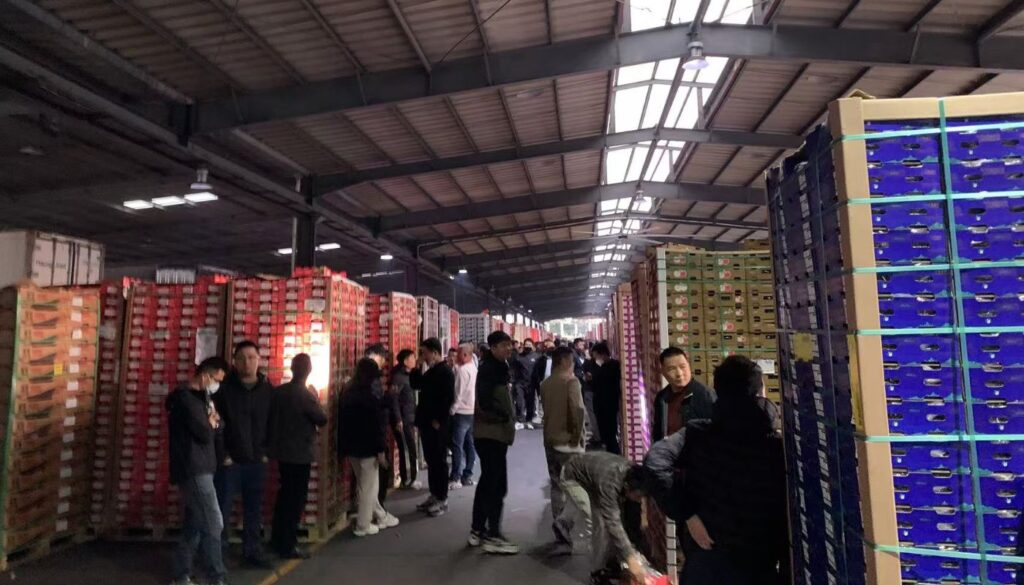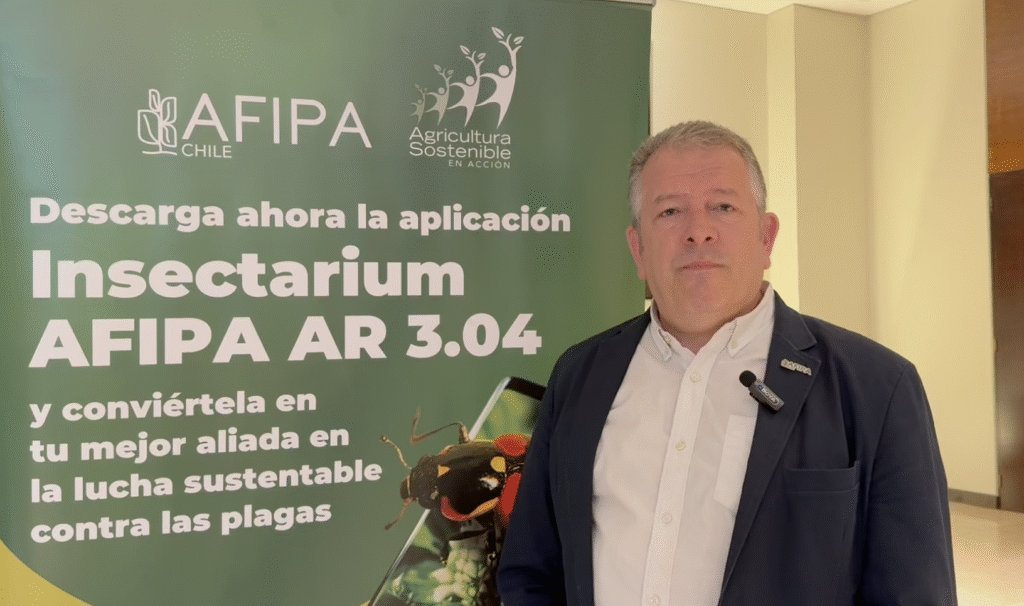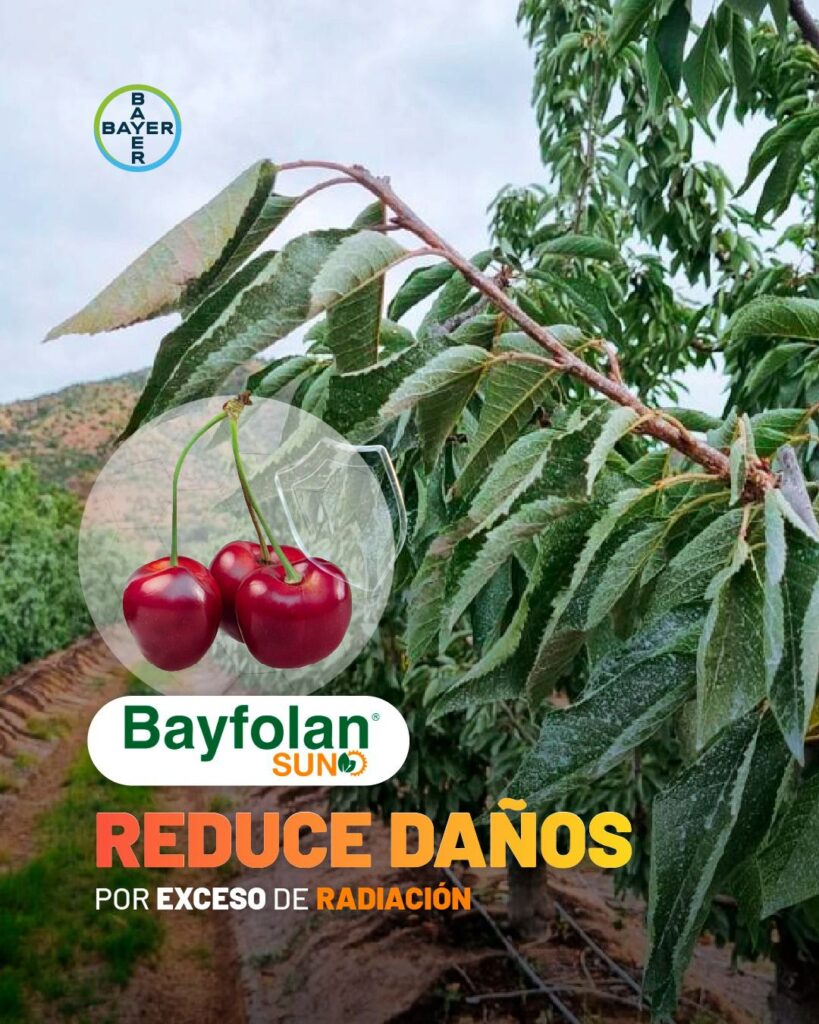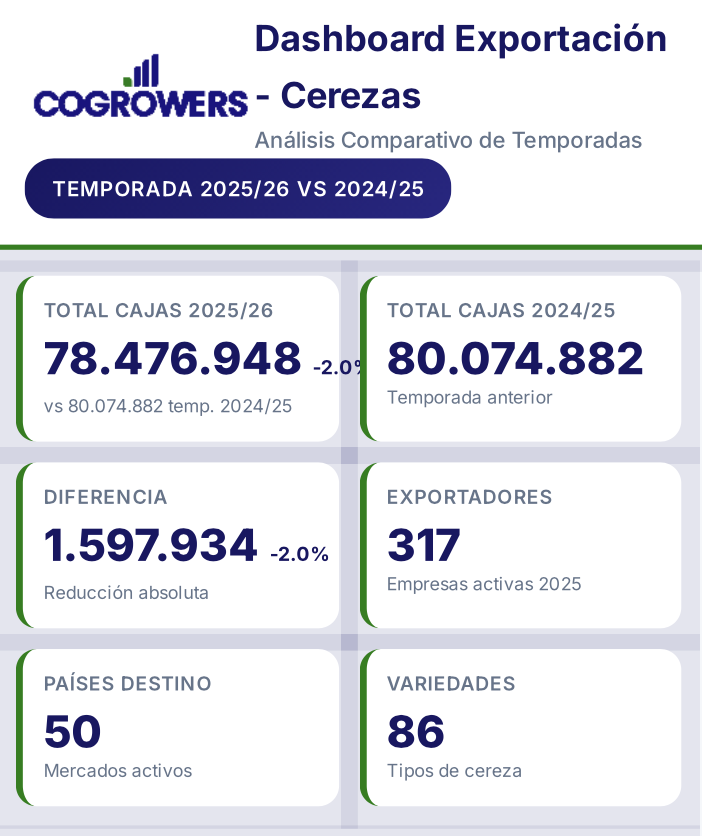By: Dr. Cecilia Ramos B., Academic University of Las Américas (UDLA), Co-Founder Laboratorios Diagnofruit Ltda, Member SOCHIFIT and AMICH. [email protected]
Hector Garcia O., Co-Founder and General Manager of Diagnofruit Laboratories Ltda, SOCHIFIT and AMICH Member. [email protected]
More than one person might point out that in our reality, talking about bacteria is simple, because it is a rather short chapter in books and courses on phytopathology; however, in reality it is one of the most complex areas in terms of etiology, epidemiology and control, a story that can become a real nightmare, as we will see later.
A clear example of the impact of bacteria on modern fruit growing, two bacterial diseases have shaken the sector worldwide in recent years. The first is known as Huanglongbing or Yellow Dragon Disease, which has generated tireless and accelerated work by many researchers to revitalize the citrus industry in the USA and other countries, where losses have been multimillion-dollar; the causal agent Candidatus liberibacter spp. It still has a provisional accessory name, “Candidatus”, because the microorganism cannot yet be cultured, which multiplies the difficulties of study. (1).
The second disease, much closer to our reality, is Kiwi Bacterial Cancer, caused by Pseudomonas syringae pv. actinidiae (Psa), a much newer disease than the previous one, first described in the 80's in Japan (2) and then in the mid-1990's in Japan (3).
The disease was first detected in Italy in the 1990s (3); however, in those first detections the disease was nothing more than a local problem with mild to moderate virulence. A decade later the situation changed dramatically, and a real crisis began, first described in Italy (4), but it quickly spread throughout the world, becoming a pandemic, decimating successful and valued varieties such as Hort16A; to give an idea of the magnitude of the problem, in New Zealand losses have been estimated between €330-400 MM in the period 2012-2021.
So what happened? Why does a bacteria go from causing a mild disease to one that is pandemic and extremely aggressive? The answer becomes more complex as we advance in knowledge, one aspect to consider is that Psa It has genetic variants, in this case, characterized as biovars; the first one detected in Japan was called biovar 1 and that of the pandemic and that, in addition, is in our country was called as biovar 3 (5), but this does not end there, because to date at least 6 biovars have been described. However, this only answers part of the question, so it is worth asking: was it hidden in China (6) and what happened was that we introduced it, unknowingly, into our production systems through contaminated material? Or is it a recent, highly adapted variant? Although the answers are not yet conclusive, we know some strategies that bacteria have to adapt and that are crucial to establish efficient control programs.
Bacteria, examples of adaptation through communication
Undoubtedly, these microorganisms possess various techniques to generate processes that will end in offspring better adapted to the environment they want to conquer. Below, we will quickly review the most important ones.
A few years ago we attended a world congress in Portugal where there was a space for Pseudomonas, and a poster was very eye-catching, it had a title like this: “Pseudomonas: Sex, Drugs and Rock'n Roll…” which referred to two important adaptation mechanisms: the first, the ability to transmit genetic information through “simple” steps (sex) and the second, the acquisition of resistance to biocides (drugs). Bacteria have a mechanism for transferring genetic information, which some refer to as a similarity to sexual reproduction, with the difference that the transmission of genes is horizontal. For this to occur, there must be a donor bacterium and a recipient bacterium; both bacteria are connected through a “pilus” (bridge), and the donor shares a gene package with the recipient; within this package there may be information for, for example, resistance to bactericides, heavy metals, synthesis of new molecules, etc. The most common gene packages in Pseudomonas are plasmids and integrative conjugative elements (7). In this way, a Pseudomonidae It can pass key information to a bacteria that has just arrived in the ecosystem, regardless of its species, thereby ensuring the success of the adaptive process of various populations within the orchards, which is why control is so complicated.
Using state-of-the-art analytical tools, and to further complicate the situation, we have realized that populations, for example, in a canker or smut flower, are not only colonized by one species of bacteria, but that many species coexist and probable imbalances can end in the generation of a disease by virtue of the dominance of one or more pathogenic species. In Figure 1 we can see a summary of the frequencies of different bacterial species that we detected in a single active cherry canker, showing how these populations coexist, communicate and cooperate for successful colonization.
Main phytopathogenic bacteria present in fruit trees in Chile
According to modern evidence, as already described, bacteria would act by forming blocks in orchards; however, there are highly pathogenic bacteria whose mere presence is a complication in sustainable production.
Probably the best known species is Pseudomonas syringae pv. syringae (Pss), which affects stone fruit, seed, kiwi, among others; it has currently acquired special relevance due to its destructive power in cherry trees, the crop with the greatest projection in Chile. Causal agent of Bacterial Cancer or Canker, Pss It is capable of killing plants, and can also cause flower blight and reduce production during the season. Recently, we detected a variant, Pseudomonas syringae pv. morsprunorum (Psm) (8), very similar to Pss in terms of damage and is currently under official control by the Agricultural and Livestock Service (SAG). Although in Chile there are no clear estimates of losses due to the Pseudomonas In cherry trees, world literature mentions losses of up to 75%, due to plant death (9).
Within the Pseudomonidae, the chapter referring to Psa bv.3 in kiwis becomes important due to the pandemic that it caused and that devastated yellow-fleshed varieties. Also, as mentioned, it is common to find even sympatrically Pss and Pseudomonas viridiflava, This last species is more associated with button and/or flower blight, a disease capable of generating direct losses, close to 40%, as recorded in the spring of 2018 in the Curicó area.
The last important group is made up of the genus Xanthomonas, where the species Xanthomonas arboricola pv. juglandis (Xaj) It is the one that directs the management plans in walnut orchards in order to avoid the appearance of Black Death, especially in situations of humid and temperate springs (10,11). In walnut orchards in the southern area of Chile, losses of up to 80% of production have been recorded, making this pathogen one of the main limitations for sustainable production (12).
Critical points in achieving optimal and sustainable bacterial control in fruit orchards
We already know that bacterial populations communicate and adapt relatively easily to ecosystems, which is why they have been efficient colonizers of the planet since life appeared, so it is not unlikely that control will be complex, which is why we must learn to live with them and generate balance as the central axis of integrated management.
In this way, a garden must always start by generating a NUTRITIONAL BALANCEWithout going into depth, the main factor that alters the post-harvest life of a fruit is often the concentration of nitrogen in it, which generally comes with dense canopies and poor lignification of shoots and trunks, which ends in fruit susceptible to rot and a plant with a shorter shelf life due to not offering natural resistance to pathogenic bacteria and fungi. Thus, the first point to check is the balance of macro and micronutrients in plants and fruits (13), performing tissue analysis at different times of the season and in a systematic way, in order to compare the data generated year after year and define the balance point for each orchard, relating vigor, production, fruit quality, disease development, etc.
The second critical point to consider is the GOOD DIAGNOSIS, essential within an integrated management framework. It is easy to confuse certain diseases and symptoms, such as, for example, a canker of bacterial origin and another caused by fungi such as Cytospora (false cancer), which causes little success in control. To obtain a good diagnosis, laboratory analyses are essential and today molecular biology at our service gives us greater certainty in finding the real causal agent of a disease. For the diagnosis to fulfill its function, it must be timely, and in this sense, the sample must be taken at the time when the first symptoms appear. A classic example is what happens with Necrotic Spot in cherry trees caused by Pseudomonas; We have observed that after a couple of weeks the recovery of pathogenic isolates is almost zero, as temperatures increase the bacteria's presence decreases.
The third critical point is the design of a PHYTOSANITARY PROGRAM adapted to each reality. Which products and when to use them are unknowns that a good program to control bacteria works on, considering anti-resistance management and low impact on the environment. In classical terms, both Pseudomonas and Xanthomonas They are mainly controlled in the field with copper and antibiotics, although the modern trend is to also incorporate biocontrol and the use of elicitors to support the above.
Copper, advantages and disadvantages of an old antimicrobial
The modern history of the use of copper for pathogen control in plants began at the end of the 19th century, when it was observed that vines treated with copper reduced mildew attacks. In Chile, we use various formulations based on this metal, which are used to a greater or lesser extent for the management of pathogens. Pseudomonas and Xanthomonas. Its activity is based on the release of Cu+2, also called ionic copper, which is capable of intoxicating cells and generating the expected bactericidal effect. In this way, there is a release kinetics that will be faster by virtue of the formulation used, the initial amount deposited, presence of compounds in the plant that act as complexing of Cu and the climate (precipitation). As an example, copper sulphate pentahydrate releases Cu faster+2 in high proportions, compared to what an application of copper hydroxide generates, but the latter would grant a more extended release, this data is key to determine what type of copper to use and when to apply, always considering that it is a preventive use and that it will act as protective of the treated tissue.
Populations of Pseudomonas and Xanthomonas Copper-tolerant species have been previously detected in Chile (10,11,14), which added to the eventual difficulty of certain coppers to release Cu+2 At the right time, they categorize this element with low effectiveness, and it must be applied consecutively during the season in order to increase control. This creates a new complication, copper poisons plants and their environment, accumulates in the soil and alters the microbiota considerably. These and other negative considerations about copper prompted the creation of a European Union regulation (Reg no. 473/2002) which sets a progressive reduction that could reach 5 kg/ha/year of total copper for the next few years. In a study (15) that evaluated the contamination of soils in the central zone by different heavy metals, the results obtained from sampling in the Regions of Valparaíso and O'Higgins stand out, where high concentrations of copper were detected, of 200 and 176 mg kg-1 respectively, closely linked to cities with high mining or agricultural activity; the average Cu in the earth's crust is considered to be 60 mg kg-1 (16).
Currently, various formulations are available on the market that have a dual purpose and use Cu as a base. An interesting product in this line is based on the mixture of Copper Sulfate & Chitosan; in this way, the bactericidal effect of copper is combined with a powerful elicitor, which will increase the defenses of the plants, raising the resistance to biotic and abiotic stress.
Specific bactericides, when to use them?
From a historical perspective, the widespread use of specific bactericides in fruit growing originated with Fire Blight, a disease caused by Erwinia amylovora in pome fruit. Its low toxicity and relatively high efficacy have made streptomycin a fundamental tool for controlling the disease. As expected, populations resistant to streptomycin began to appear, which encouraged the use of other molecules such as oxytetracycline. Calculations made in the USA in 2009 indicate that only 0.12% of the total volume of antibiotics used are associated with fruit growing, a figure that would reflect the low impact in relation to clinical use in humans and productive use in animals (17).
In Chile, three formulations are authorized and used for bacterial control: streptomycin & oxytetracycline, gentamicin & oxytetracycline, and kasugamycin. Formulating a mixture of two active ingredients aims to reduce the selection of populations, prevent the appearance of resistant individuals, and as a result increase the effectiveness of control over the different pathogens in the field. In this way, it is necessary to favor the use of mixed formulations.
One of the limitations of copper, as mentioned, is its ability to poison susceptible tissues, which is why it is not used during flowering; however, this phenological state is the period in which favorable conditions increase for Pseudomonas and Xanthomonas, due to the susceptibility of the crop, it is a time of stress for the plant, and also depending on favorable conditions for bacterial growth in spring (high humidity and temperatures) which progressively means that, as flowering progresses, there is a greater presence of bacteria, increasing the risk of damage, as we have been able to quantify in recent seasons (Fig. 3).
In susceptible orchards and/or those with high production, during an early spring with a forecast of rain or high relative humidity, the flower must be protected and this is where these bactericides work well, considering these tools as a fundamental pillar for maintaining the health of the orchard. However, a factor to consider: Streptomycin applications in full flower increase fruit abscission in walnut, so they are not recommended (18) for the control of Xaj.
In response characterization studies in vitro to specific bactericides by pathogenic isolates of Pss and Psm rescued from cherry trees, we have observed a better performance of gentamicin & oxytetracycline over other standards, such as the case of streptomycin & oxytetracycline and much higher than kasumigacin (Fig. 4), by observing and quantifying a greater inhibitory halo in disk antibiograms (Kirby-Bauer) which makes us project a better control in the orchard, thinking of, for example, flower applications.
Final considerations and projections on bacteria control
Modern bacteria control in fruit orchards should be carried out under the guidelines of integrated management. In this way, the first thing to do is to achieve nutritional balance, reduce vigor, avoid the ravages of frost, excess radiation on the trunks, attacks by wood-eating insects and nematodes, in short, everything that makes the wood susceptible and causes wounds.
At the same time, and just as important as the above, two activities must be mentioned that must be put into practice. The first is a good diagnosis. We must know if the orchard is being affected by bacteria or pathogens that cause similar symptoms. Samples of symptomatic tissues must be taken to a laboratory, just as a doctor performs tests on his patient. The second activity is built with the diagnosis, and is the generation or updating of the phytosanitary program.
As we have already analyzed, PREVENTION is essential to defeat
Therefore, we must have a basic plan for critical stages such as flowering, leaf fall or pruning and a dynamic plan for predisposing conditions, such as frost events. Without a doubt, avoiding the acquisition of resistance to copper and specific bactericides in the bacterial populations of our orchards must be the main axis of our phytosanitary program after ensuring preventive efficacy in any event. As a first recommendation, we must reduce the application load in our orchards, using the idea of the previous paragraph: set applications in critical phenologies and the rest only under predisposing conditions. The rotation of active ingredients and different modes of action is crucial. In the case of antibiotics we find that all those that are registered for use in fruit trees block the protein synthesis process, therefore, the possibility of rotation is limited in terms of varying the mechanism of action; however, unlike streptomycin, gentamicin binds to several sites on the ribosome; Therefore, several mutations in the bacterial chromosome are needed to generate spontaneous mutants resistant to gentamicin (19). At the same time, the formulation of bactericides in mixture is a very effective anti-resistance strategy. In this way, the bactericide composed of gentamicin & oxytetracycline becomes a fundamental tool for the effective control of bacteria in the base program.
In the search for phytosanitary programs with a lower impact, we are now looking much more closely at and recommending the use of biological control to reduce the inoculum pressure of bacteria and fungi; in this way we have been able to verify the power of control in in-vitro tests.
of products based on Bacillus They are seen as a very good complement to the base program in critical stages, such as sprouting, pruning and leaf fall.
Finally, we must generate stronger plants that resist pathogen attacks and today there are tools that increase defenses, various chitosans and other compounds that activate the Acquired Systemic Resistance pathway must be considered within a comprehensive disease management scheme.
Cited Literature
- Merfa, MV, Pérez-López, E., Naranjo, E., Jain, M., Gabriel, DW, & De La Fuente, L. (2019). Progress and obstacles in culturing 'Candidatus Liberibacter asiaticus', the bacterium associated with Huanglongbing. Phytopathology, 109(7), 1092-1101.
- Serizawa, S., Ichikawa, T., Takikawa, Y., Tsuyumu, S., & Goto, M. (1989). Occurrence of bacterial canker of kiwifruit in Japan. Japanese Journal of Phytopathology, 55(4), 427-436.
- Scortichini, M. (1994). Occurrence of Pseudomonas syringae pv. actinidiae on kiwifruit in Italy. Plant Pathology, 43(6), 1035-1038.
- Balestra, GM, Mazzaglia, A., Quattrucci, A., Spinelli, R., Graziani, S., & Rossetti, A. (2008). Bacterial canker on Actinidia chinensis. Informatore Agrario, 64(38), 75-76.
- Miranda, E.; García, H.; Pedroso, I. and Ramos C. (2018)-. Phylogenetic study of Chilean isolates of Pseudomonas syringae pv. actinidiae in Actinidia spp. XXVI Congress of the Chilean Society of
Plant Pathology Austral University of Chile Valdivia, November 2018. - Butler, MI, Stockwell, PA, Black, MA, Day, RC, Lamont, IL, & Poulter, RT (2013). Pseudomonas syringae pv. actinidiae from recent outbreaks of kiwifruit bacterial canker belong to different clones that originated in China. PloS one, 8(2), e57464.
- Zhao, M., Butler, M., Taiaroa, G., & Poulter, R. (2017, September). Conjugation in Pseudomonas syringae pv. actinidiae (Psa). In IX International Symposium on Kiwifruit 1218 (pp. 327-332).
- García, H., et al. (2021). First Report of Bacterial Canker Caused by Pseudomonas syringae pv. morsprunorum Race 1 on Cherry in Chile. Plant Disease online. https://doi.org/10.1094/PDIS-11-20-2524-PDN
- Spotts R., Wallis K., Serdani M., and Azarenko A. (2010). Bacterial Canker of Sweet Cherry in Oregon—Infection of Horticultural and Natural Wounds, and Resistance of Cultivar and Rootstock Combinations. Plant Disease, 94:3, 345-350
- Moya-Elizondo, E., Auil, P., Oyarzúa, P., & Gerding, M. (2018). COPPER ION RESISTANCE OF Xanthomonas arboricola pv. juglandis IN NOCEDALES OF THE BIOBÍO REGION. Chilean journal of agricultural & animal sciences, 34(1), 3-11.
- Esterio, M., Auger, J., Agurto, L. & Pérez, E. (2006). Resistance of «Xanthomonas arboricola» pv. «juglandis» to copper ion in Chile. Phytopathology, ISSN 0430-6155, 41(3): 93-101.
- Moya, E. (2017). The challenges of controlling black plague in the south. Redagricola Chile, May 2017.
- Dordas, C. (2008). Role of nutrients in controlling plant diseases in sustainable agriculture. A review. Agronomy for sustainable development, 28(1), 33-46.
- Beltrán, M., Sagredo, B., Osorio, V., Millas, P., France, A., & Lemus, G. (2019). Characterization of the causal agent of bacterial cancer in cherry. Redagrícola, Nov 2019
- Burgos, O. (2017). Distribution and evaluation of AS, CD, CU, NI, PB, SE and ZN, in agricultural soils of the Central Zone of Chile. PROJECT REPORT FOR THE DEGREE IN CIVIL ENGINEERING. Universidad de la Santísima Concepción.
- Rehman, M., Liu, L., Wang, Q. et al. (2019). Copper environmental toxicology, recent advances, and future outlook: a review. Environ Sci Pollut Res 26, 18003–18016.
- Stockwell, V.O., & Duffy, B. (2012). Use of antibiotics in plant agriculture. Revue Scientifique Et Technique-Office International Des Epizooties, 31(1), 199-210.
- Polito, V.S., Pinney, K., Buchner, R., & Olson, W. (2002). Streptomycin applications to control walnut blight disease can prevent fertilization and increase fruit drop. HortScience, 37(6), 940-942.
- Stockwell VO, Duffy B. Use of antibiotics in plant agriculture. (2012) Rev Sci Tech. 31(1):199-210.








